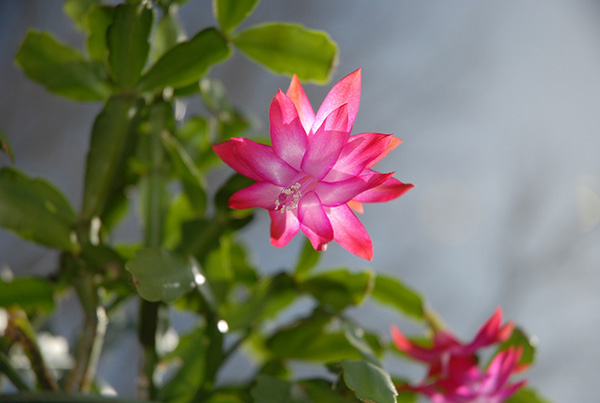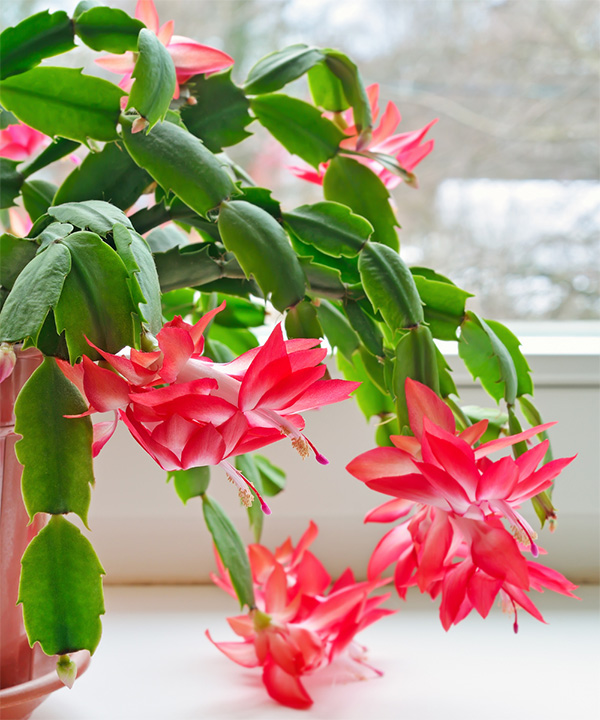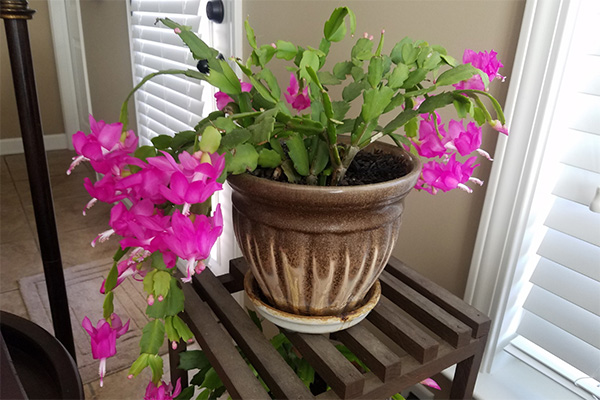Native to the Brazilian rainforests, the Christmas Cactus is cherished for its beautiful, tubular flowers that bloom just in time for winter festivities. Unlike the typical desert cacti, this unique variety thrives in a more humid environment and requires a different set of care routines.
In this guide, we'll explore the key elements to care for a Christmas Cactus plant, including proper watering, lighting, temperature, and blooming tips. Whether you're a seasoned gardener or a newcomer to plant care, our easy-to-follow advice will help you nurture a healthy, blooming Christmas Cactus that can be enjoyed year after year.
Botanical Name
Common Name
Plant Type
Mature Size
Sun Requirement
Soil Type
Hardiness Zone
Pet Friendly
Schlumbergera bridgesii
Christmas Cactus
Cactus/Succulent
0.5 to 3 feet tall and wide
Partial shade
Well-draining, sandy soil
9-11 USDA
Yes
What are Christmas Cactus Plants
The Christmas Cactus, scientifically identified as Schlumbergera bridgesii, is a well-loved indoor plant renowned for its vivid and colorful flowers that typically bloom during the holiday season. Native to the tropical rainforests of Brazil, this plant is a member of the Cactaceae family, but unlike typical desert cacti, it thrives in a more humid, forest-like environment.
Characterized by its segmented, flat green leaves and beautiful flowers in shades of red, pink, purple, orange, and white, the Christmas Cactus is a true standout. The blooms, situated at the tips of the leaves, are tubular in shape and frequently exhibit a layered, petal-like appearance.
Christmas Cacti are recognized for their longevity, and when provided with appropriate care, they have the potential to bloom year after year. Part of the holiday cactus, Christmas cacti typically flower in late fall to early winter, adding a splash of color during the darker months. Their unique growth habit and stunning floral display make them a favorite among plant enthusiasts and a delightful addition to holiday decor.

Common Varieties
Multiple varieties of Christmas Cactus exist, each possessing its distinctive characteristics. Some of the most popular include:
Schlumbergera bridgesii (True Christmas Cactus): This is the classic Christmas Cactus, known for its smooth, scalloped edges on the leaves. The flowers display various colors, encompassing shades such as red, pink, purple, orange, and white.
Schlumbergera truncata (Thanksgiving Cactus): Frequently mistaken for the Christmas Cactus, this variety is distinguished by pointed, tooth-like projections along the edges of its leaves. It typically blooms a bit earlier than the Christmas Cactus, around Thanksgiving.
Schlumbergera gaertneri (Easter Cactus): Blooming in the spring around Easter, this variety has star-shaped flowers and rounded leaf segments. This variety is less prevalent compared to the Christmas and Thanksgiving Cacti.
Schlumbergera 'Buckleyi': This is a hybrid variety that's similar to the true Christmas Cactus but has more tubular, symmetrical flowers.
Schlumbergera hybrids: There are many hybrid varieties of Christmas Cactus available, bred for a variety of flower colors and forms. These can range from bright, solid colors to bi-colors and even ruffled or double flowers.
Christmas Cactus Care Requirements
Light
The Christmas Cactus has specific light requirements that vary slightly between indoor and outdoor environments. Whether cultivated indoors or outdoors, ensuring the appropriate amount of light is essential for the well-being of your Christmas Cactus, particularly to stimulate blooming. During the shorter daylight hours of fall and winter, when the Christmas Cactus typically blooms, ensuring it gets enough light is even more important.
When grown indoors, Christmas Cacti grow best in bright light and indirect. Direct sunlight can be too harsh, especially during the hot afternoon hours, and may cause the leaves to turn yellow or red as a sign of stress. A location near an east or north-facing window is ideal, as it will receive plenty of light without the intense direct sun. Placing the plant under a grow light can also work well if you don't have a spot with natural indirect light.
Even if you are cultivating a Christmas Cactus outdoors, it still requires protection from direct sunlight. A shaded spot that receives filtered sunlight or partial shade is best. This can be under a tree, on a covered patio, or in an area that gets morning sun and afternoon shade. Excessive exposure to direct sunlight can damage the leaves and flowers, whereas insufficient light may hinder the flowering of the Christmas Cactus.
Water
The Christmas Cactus requires consistent watering, whether grown indoors or outdoors, but the frequency and amount can vary based on the environment and season. Regardless of the location, the key to watering a Christmas Cactus is to maintain a balance; the soil should be kept moist but not soggy. Adapt your watering schedule based on seasonal changes, temperature, and humidity to keep your Christmas Cactus healthy and thriving.
The Christmas Cactus thrives for indoor cultivation when the soil is consistently moist but not waterlogged. Water the plant thoroughly, allowing excess water to drain from the pot. Before the subsequent watering, allow the top inch of soil to slightly dry out. It's crucial to ensure good drainage to prevent the risk of root rot associated with overwatering. In the winter months, particularly when the plant is in bloom, slightly reduce watering but avoid letting the soil dry out completely.
A Christmas Cactus may require more frequent watering due to increased light and temperature exposure when grown outdoors. Nevertheless, like indoor plants, permit the top inch of soil to dry out between watering sessions. In regions with high rainfall, ensure the plant is not in excessively soggy soil. During the cooler months or in periods of rain, reduce watering to prevent over-saturation of the soil.
Temperature
The Christmas Cactus thrives in a moderate and consistent temperature range, usually between 60°F to 70°F (15°C to 21°C). While it adapts well to typical indoor temperatures, it should be shielded from extreme heat or cold. Sudden temperature fluctuations and drafts can stress the plant, especially during blooming. During its blooming phase in the winter, cooler nighttime temperatures around 55°F to 60°F (13°C to 16°C) can help promote flower bud development. It's important to keep the plant away from heating vents, air conditioners, and drafty windows to maintain a consistent temperature. Proper temperature management is crucial for the health and blooming success of a Christmas Cactus.
Humidity
The Christmas Cactus, native to the humid rainforests of Brazil, requires a humid environment to mimic its natural habitat. This plant flourishes when the humidity level is around 50-60%, which is often higher than the average indoor environment, particularly in homes with central heating or air conditioning.
To maintain the appropriate humidity level for a Christmas Cactus, several methods can be employed:
Humidifier: Using a humidifier in the room where the plant is located is an effective way to increase and regulate humidity levels.
Pebble Tray: Position the plant pot on a tray filled with water and pebbles. As the water in the tray evaporates, it increases the moisture in the air surrounding the plant. Ensure that the pot rests on the pebbles and not directly in the water to prevent the risk of root rot.
Misting: Regularly misting the Christmas Cactus can provide a quick humidity boost. Nevertheless, it's crucial not to overdo it, as an excess of leaf moisture can result in fungal problems. Misting is more effective when combined with other methods of increasing humidity.
Grouping Plants: Arranging multiple plants together can generate a microclimate with elevated humidity through collective transpiration.
Avoiding Dry Areas: Keep the Christmas Cactus away from sources of dry air, such as heating vents or drafty windows.
Maintaining a higher humidity level is particularly important during the plant's active growth and blooming phases. Adequate humidity not only supports the overall health of the Christmas Cacti but also enhances its flowering potential, ensuring the plant remains a vibrant and attractive feature in your home.

Soil
The Christmas Cactus necessitates well-draining potting soil that retains moisture without becoming waterlogged. A good potting soil mix for a Christmas Cactus includes components like peat, perlite, and sand, which provide both aeration and moisture retention. The ideal soil should be slightly acidic to neutral in pH. Many gardeners use a standard cactus or succulent potting mix and enhance it with additional perlite or vermiculite to improve drainage. Ensuring the soil has proper drainage is crucial, as the Christmas Cactus is prone to root rot if left in soggy soil. Frequently inspect and refresh the soil to sustain the plant's well-being and promote blooming.
Fertilization
The Christmas Cactus benefits from regular fertilization during its active growing season to support its overall health and flowering. Utilize a balanced, water-soluble fertilizer, like a 20-20-20 formula, diluted to half the recommended strength. Fertilize every two weeks from late winter to late summer. During the fall, as the plant prepares to bloom, reduce fertilization to encourage Christmas Cactus blooms. Following the blooming period, discontinue fertilization to give the plant a resting phase. Avoid over-fertilizing, as this can result in excessive growth at the expense of flowering. Proper fertilization is key to vibrant blooms and a healthy Christmas Cactus.
Propagating
Propagating a Christmas Cactus is simple and typically done through stem cuttings. Propagating new plants through Christmas cactus cuttings is easy and rewarding. Here's how to propagate your Christmas Cactus:
Select a robust stem with at least two to three connected segments. Healthy stems are more likely to root successfully.
Using a sharp and clean pair of scissors or a knife, cut the selected stem segments between the joints, ensuring a precise cut.
Permit the cuttings to dry for a few hours or overnight before proceeding with the propagation process. This helps to form a callus on the cut end, reducing the risk of rotting when planted.
Fill a small pot with a well-draining soil mix, like a cactus or succulent mix. Improve drainage by incorporating perlite or coarse sand.
Insert the calloused end of the cuttings approximately an inch deep into the soil. Multiple cuttings can be planted in the same pot.
Gently water the soil, providing enough moisture to dampen it. Avoid overwatering, as too much moisture can cause the cuttings to rot.
Position the pot in a well-lit area with indirect sunlight. Steer clear of direct sun exposure, which may be too intense for the newly propagated cuttings.
Roots typically begin to develop in a few weeks. You can gently tug on the cuttings to assess resistance, indicating the roots' formation.
After the cuttings have successfully rooted, provide care for them like you would for a mature Christmas Cactus. Transition them gradually to the regular watering and feeding schedule.
Propagation is most effective when conducted in late spring or early summer, coinciding with the plant's active growth phase. This technique is excellent for generating new plants or sharing with friends and family.
Potting and Repotting
The Christmas Cactus benefits from repotting every two to three years to refresh the soil and accommodate growth. Opt for a pot slightly larger than the current one, as an excessively large pot can retain excess moisture, potentially leading to root rot. Ensure the new pot has adequate drainage holes for water drainage. During repotting, use a well-draining soil mix like a cactus or succulent blend, incorporating perlite or sand for improved drainage. The optimal time for repotting is in late winter or early spring, before the commencement of the growing season. Carefully extract the plant from the old pot, shake off the old soil, and place it in the new pot with fresh soil, being mindful not to bury the stems too deeply. Proper potting and repotting help maintain the health and vigor of your Christmas Cactus.

Common Problems And Troubleshoots
Dropping Flower Buds
This is a common issue, especially when environmental conditions change suddenly. To prevent issues, maintain a stable environment in terms of temperature, light, and water. Avoid moving the plant once buds start forming, and keep the watering schedule consistent to reduce stress on the plant.
Wilting or Limp Leaves
Often indicative of water issues. Excessive watering may result in waterlogged soil and root issues, whereas insufficient watering can lead to plant wilting. Before watering, assess the soil to ensure it is adequately moist without being saturated. Tailor your watering routine to achieve the optimal balance that suits your plant's specific requirements.
Root Rot
This significant problem typically arises from overwatering and inadequate drainage. Planting your Christmas Cactus in well-draining soil and using a pot with drainage holes is crucial. If you suspect root rot, remove the plant from its container, examine the roots, and trim away any blackened or mushy portions. Repot the plant in fresh, dry soil to promote a healthier environment.
Pests
Christmas Cacti are susceptible to infestations by pests such as aphids, spider mites, and mealybugs. Conduct routine inspections to detect early signs of pest presence. In case of infestation, promptly address it using insecticidal soap or neem oil to prevent further spreading. Elevating humidity levels around the plant is an additional measure that can discourage pest activity.
Pale or Yellow Leaves
This can occur when a Christmas Cactus is exposed to too much direct sunlight, leading to leaf scorch. Move the plant to a location with bright, indirect light to shield it from intense sunlight.
Lack of Christmas Cactus Bloom
Insufficient light, temperature fluctuations, or improper watering can prevent a Christmas Cactus from blooming. Ensure that the plant is situated in a location with sufficient indirect light. Encourage the Christmas cactus to bloom by subjecting the plant to cooler nighttime temperatures, approximately 55°F, for several weeks before the expected flowering period.

